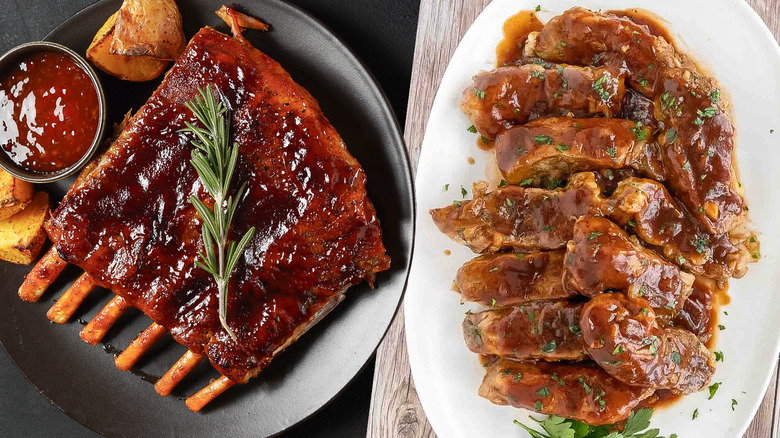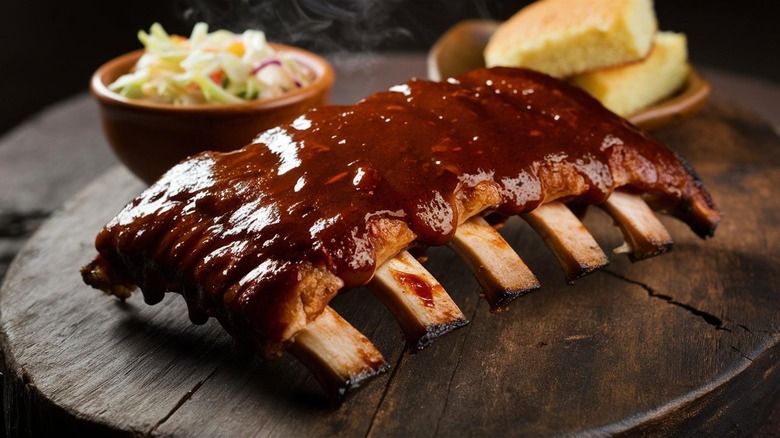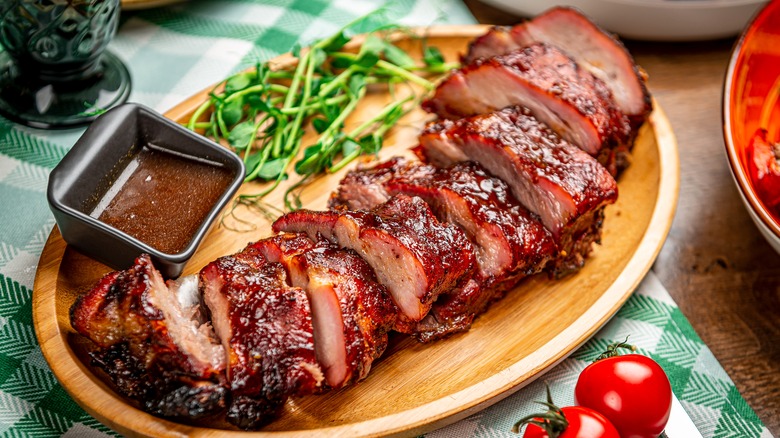The Differences Between Traditional And Country-Style Ribs
We may receive a commission on purchases made from links.
Ribs are a beloved barbecue tradition, but check out our ranking of every rib cut from worst to best, and you may notice that country-style ribs don't get a mention. That's because, despite their name, they're technically not ribs at all.
When you hear about "traditional" ribs, you likely imagine a plate of barbecued baby back ribs or spare ribs, both of which come from the rib section of the pig. Kansas City-style and St. Louis-style ribs also fall into this category — they're still spare ribs, just more trimmed down. Many barbecue fiends might also argue that beef ribs are stars themselves; still, whether you consider them traditional or not, beef ribs come from (you guessed it) the rib section of the cow.
Country-style ribs, however, are a different story. These are more like pork chops than ribs, as they're cut from the pork shoulder or loin. They're meatier and often boneless, but if they are bone-in, this bone comes from the shoulder rather than the rib section. Where they're cut from is the main factor that sets country-style ribs apart from traditional ribs, but this isn't the only difference to keep in mind when preparing each of these barbecue favorites.
Traditional ribs are a barbecue classic
If you opt for arguably the most traditional barbecue ribs — pork — there are a few noticeable differences depending on where in the rib section they come from. Baby back ribs are cut from the upper part of the ribs closer to the back, where the ribs are smaller and leaner. Spare ribs, on the other hand, come from the rib section around the belly and are larger, meatier, and fattier. Either way, both kinds benefit from slow-and-low cooking (although spare ribs take more time to cook), which helps tenderize their connective tissues, resulting in a lip-smacking, fall-off-the-bone texture.
Smoking is a popular way to cook traditional ribs, as it allows the meat to absorb smoky flavors while becoming tender. Ribs can also be slow-roasted, which is a must before saucing them up and finishing them on the grill or under a broiler. One of the biggest mistakes you can make when cooking ribs is to slap a raw rack right over hot coals without cooking them first.
Traditional ribs are synonymous with barbecue culture, so they're often made with bold spice rubs or barbecue sauces. But don't pull out that basting brush too early. The ideal time to slather saucy flavor on ribs is closer to when they're done so the sauce caramelizes without burning (but we do recommend you get a head start before cooking with a good marinade or rub).
Country-style ribs are a meatier alternative
Country-style ribs are less expensive than their true-rib counterparts, but don't let the lower price fool you into thinking they're less deserving of your attention. The history behind the cut started sometime around the late 1960s or early 1970s when a butcher ingeniously decided to cut the less-popular blade pork chop so that it resembled ribs, thus making it more attractive to shoppers.
It's no wonder that the rebranding worked — country-style ribs are tasty and more versatile than traditional ribs. Because they're meatier with less cartilage and more marbled fat, they can stand up to the grill without precooking. In fact, country-style ribs can even go right in the air fryer or skillet. You can also make them the same way as traditional ribs: low and slow, smoked or roasted. They're excellent candidates for braising in liquid, and you can even cube them up and grill them like kebabs. If you want to give them a try, check out our easy country-style ribs recipe.
Their marbling ensures a juicy bite, and their meatier texture pairs well with hearty marinades and bold seasonings, so don't shy away from non-traditional flavors for this cut (like this Kewpie roasted sesame marinade). So, if you're looking for a convenient, filling pork dish without the fuss of gnawing around bones, country-style ribs are a perfect pick.


